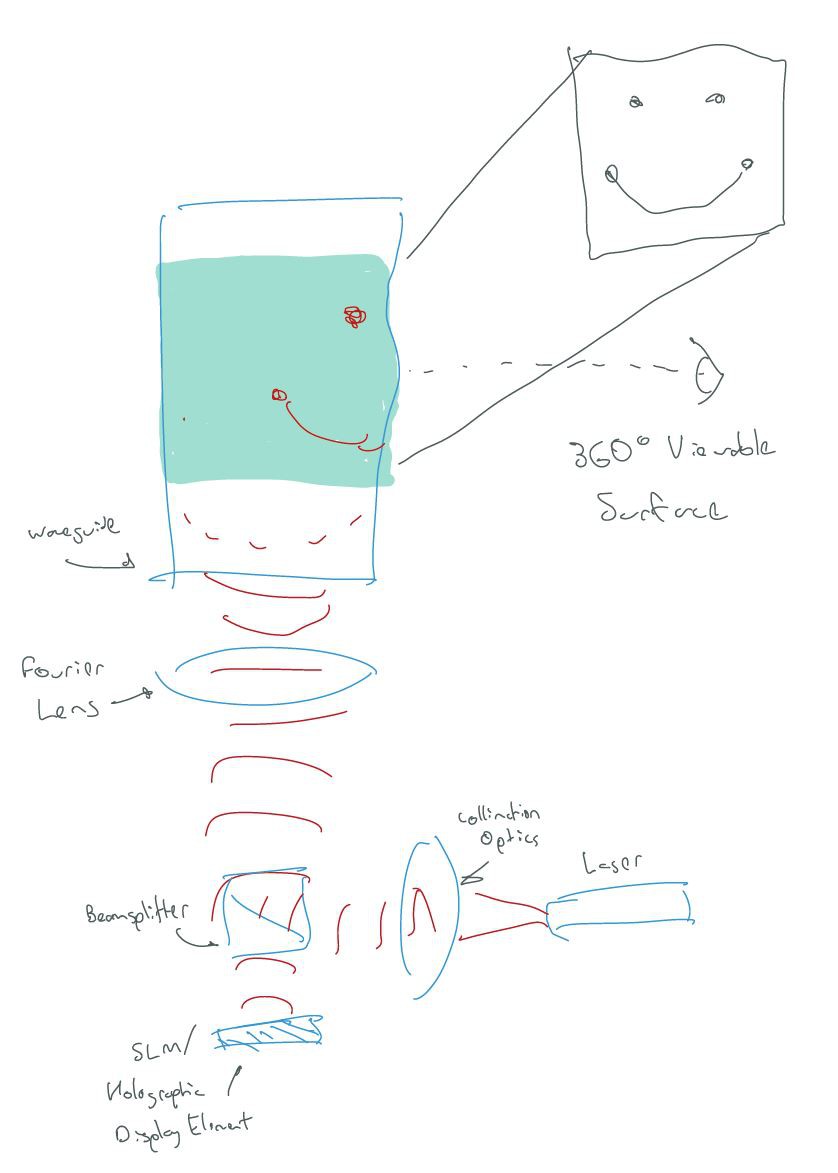Challenge - Rethinking Displays
For the Tokyo Olympics, the plan is to televise the games at 8K resolution. This corresponds to a resolution of 32 million pixels. Whilst this sounds impressive and contemporary flat, two-dimensional displays boast a phenomenal degree of visual fidelity, it can be argued that conventional 2D displays have matured to a point where the display modality can only improve so much.
Thus, the authors have looked to the past for inspiration. Holographic-approaches are not new. But in a time where pixel-counts continue to grow, novel holographic-based display modalities present a more effective means of utilising available pixel counts.
Here, we are attempting to develop a new holographic wavefront cylindrical display type. By applying holographic-techniques to appropriately perturb a wavefront, it is hoped that an image can be displayed on the perpendicular sides of a Perspex cylinder. This would result in a brand-new 360 degree viewing modality, and by appropriately manipulating the wavefronts the display can be transparent and seemingly-integrated into existing environments.
Holographic Displays
There is a large degree of confusion with what is and what is not a Hologram. The term has come to mean a wide-gamut of ghost-like images floating in the air in popular-culture (such as Princess Leia's 'Holographic' message).
However, the author might be surprised to learn that Holography is actually an extremely well-understood, mature field. Holography is the process of recording, generating and displaying wavefronts (or light fields). Moreover, Holography is not a recent development, Dennis Gabor was awarded the Nobel Prize for Holography in 1971, and its applications are widespread, as seen from the ubiquitous holographic film on the back of credit cards and passports.
Holography offers the Ultimate Display technology. For a perfect Hologram, the difference between a synthetic and real object is indistinguishable. This can be seen in the animation below, where the entire complex wavefront of several holograms can be captured in a single hologram of the scene.
In this project, we are utilising CGH (computer-generated holography), a process where a holographic wavefront is generated directly from synthetic data. This allows us to produce a wavefront which is suitably distorted to allow our display image to be projected through the Perspex waveguide and onto the surface of our transparent display.
This entire approach is based on sound, tried-and-tested scientific principles. Holography is a family of established techniques and a mature field and this provides a solid foundation for the development of new display approaches.
Display Concept
In this project, we aim to develop a novel display which can be viewed from 360-degrees through a transparent media. The display is based on Holographic Principles, where a wavefront is manipulated to allow an image to be projected onto an irregularly-shaped surface through holographic, Fourier-based techniques.
Similar displays do exist, such as Sony's 360-degree transparent holographic screen display (see https://dl.acm.org/doi/10.1145/3305367.3327974). However, this display uses conventional ray-based image projection optics in conjunction with a holographically-manufactured wavelength-dependent diffraction grating. There are significant challenges on scaling such materials to larger-sizes.
Here, we take a new approach, by incorporating Fourier-based holographic approaches into the projection optics and projecting wavefronts rather than images, it is hoped to arrive at a design which is scalable to larger screen sizes and mass-market manufacturing. The wavefronts are projected through a Perspex tube, which provides the waveguide and projection surface for the display, whilst remaining transparent and allowing the display to be seamlessly incorporated into the environment.

A key challenge with contemporary computer-generated holography is the wavefront-actuator. Phase-modulation actuators are expensive, niche scientific equipment. Hence a key enabler here is the use of HoloBlade, the world's first open-source SLM (Spatial Light Modulator) driver-stack to provide wavefront-actuation capability (https://www.osapublishing.org/ao/abstract.cfm?uri=ao-60-4-A313).
Key Resources
The repository for the open-source SLM Driver stack, HoloBlade, can be found on github at:
https://github.com/andrewkadis/HoloBlade
 Andrew Kadis
Andrew Kadis